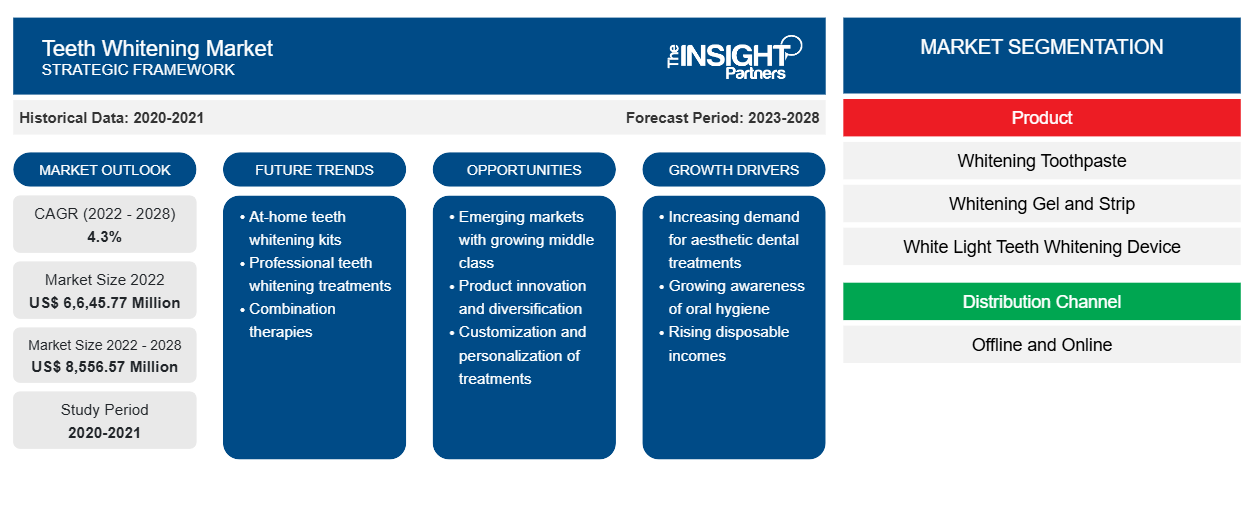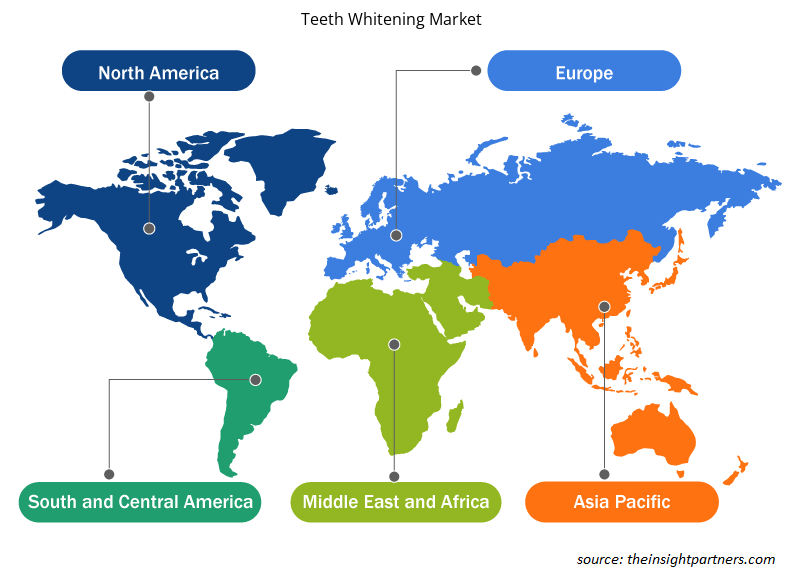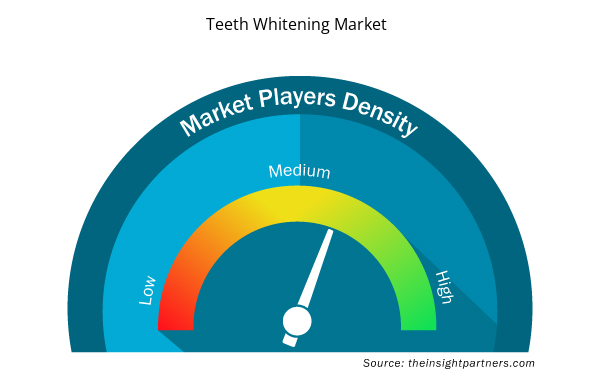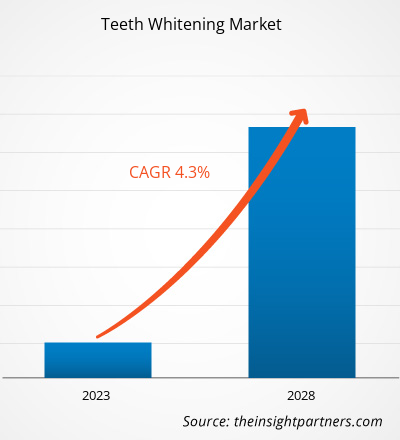The teeth whitening market is expected to grow from US$ 6,6,45.77 million in 2022 to US$ 8,556.57 million by 2028; it is estimated to grow with a CAGR of 4.3% from 2022 to 2028.
The report provides the trends prevailing in the global teeth whitening market and the factors driving and restraining the market.The market is expected to grow owing to factors such as rising awareness for oral hygiene, increased adoption of home teeth whitening kits, and technological advancements in teeth whitening products. Moreover, the boom in cosmetic dentistry is likely to boost the growth of the market in the coming years. Such factors have assisted the global teeth whitening market in the recent past and are expected to continue a similar trend over the forecast period.
Market Insights
Rising Awareness for Oral Hygiene
Oral and dental hygiene is essential to avoid oral diseases. Good oral health can be achieved by maintaining good habits and hygiene. Extrinsic teeth stains are defined as the staining of the surface of the teeth. Extrinsic tooth stains are usually caused due to consumption of tobacco and frequent consumption of coffee, tea, wine, or cola drinks. Staining below the surface of the tooth is termed intrinsic tooth staining. Furthermore, poor dental hygiene, such as inadequate flossing and brushing, leads to tooth discoloration. Various diseases that affect the teeth enamel and dentin can also result in tooth discoloration. To increase awareness about oral hygiene and teeth whitening, many private and government organizations conduct conferences, surveys, and programs worldwide to decrease the risks of oral diseases. For instance, in June 2019, Teeth Whitening Day Conference by London Dental Specialists was conducted in London, England. In addition, the Dental Education Conference conducted its 25th International conference on Dental Education in July 2020 in Florence, Italy. The conference focused on key topics such as laser dentistry, nano dentistry, tooth whitening, and pediatric dentistry. Such factors have assisted the global teeth whitening market in the recent past and is expected to continue a similar trend over the forecast period.
Customize This Report To Suit Your Requirement
You will get customization on any report - free of charge - including parts of this report, or country-level analysis, Excel Data pack, as well as avail great offers and discounts for start-ups & universities
Teeth Whitening Market: Strategic Insights

- Get Top Key Market Trends of this report.This FREE sample will include data analysis, ranging from market trends to estimates and forecasts.
You will get customization on any report - free of charge - including parts of this report, or country-level analysis, Excel Data pack, as well as avail great offers and discounts for start-ups & universities
Teeth Whitening Market: Strategic Insights

- Get Top Key Market Trends of this report.This FREE sample will include data analysis, ranging from market trends to estimates and forecasts.
Boom in Cosmetic Dentistry
Dentists have a wide range of equipment and systems which enhance the look of a patient’s teeth. Cosmetic dentistry has gained enormous popularity; it includes techniques such as whitening, shaping, closing spaces, and substituting teeth. Over time, teeth become discolored or stained due to smoking and consuming medications, foods, tea, coffee, and other food products. Using a whitening process, the dentist bleaches teeth. The dentists can perform procedures or provide products to use at home for whitening purposes. Teeth whitening procedures will never go out of demand, as most patients opt for procedures that give natural-looking white teeth that are not overly white. Super-white teeth also weaken the enamel and are observed as heavily treated teeth. Advancements in cosmetic dentistry have led to options where patients can ask for healthy and naturally white teeth. Tooth whitening has become one of the most popular cosmetic dentistry treatments among men and women, as these processes are affordable and effective. Such factors have aided the growth of global teeth whitening market.
According to the 2015 State of the Cosmetic Dentistry Industry survey, patients were seeking cosmetic dentistry procedures for several reasons such as to enhance physical attractiveness and self-esteem; for restorative or health reasons; to look younger; and for anticipated upcoming events such as marriage. Thus, cosmetic dentistry is a rapidly growing field in the dental industry. Cosmetic dentistry is flourishing and is anticipated to grow significantly due to advancements in dental technology, such as 3D printing, veneers, whitening solutions, and the growing aging population.
Product-Based Insights
Based on the product, the global teeth whitening market is segmented into whitening toothpaste, whitening gels and strips, white light teeth whitening device, and others. In 2022, the whitening toothpaste segment held the largest share of the market. Whitening toothpaste is a paste that lightens the stains on teeth and brightens teeth over some time. The number of teeth whitening options available today is attracting several consumers. The increasing popularity of teeth whitening products has prompted many manufacturers to develop products for over-the-counter and dental office use. However, whitening toothpaste is not as fast and effective as whitening strips or professional dental treatments, but it can whiten teeth over a period of time. Moreover, growing awareness about the whitening toothpaste is likely to propel the global teeth whitening market during the forecast period.
Distribution Channel-Based Insights
Based on distribution channel, the global teeth whitening market is bifurcated into offline and online. The offline segment held the largest market share in 2022. However, the online segment is anticipated to register the highest CAGR during the forecast period.
Before the onset of the COVID-19 pandemic, the global teeth whitening market grew steadily. The COVID-19 outbreak severely affected several markets, such as medical systems, in various regions. The pandemic had significantly impacted the global teeth whitening market. The COVID-19 pandemic had spotlighted the focus on personal hygiene and home dental aesthetics. The pandemic increased the market growth in the recent past and is expected to follow a similar trend over the forecast period. Moreover, studies conducted by Colgate-Palmolive suggest that certain oral care products may play a role in temporarily reducing the amount of SARS-CoV-2, the virus that causes COVID-19, in the mouth. Laboratory tests found that certain toothpaste types containing zinc, stannous fluoride, amine fluoride, and mouthwashes containing cetylpyridinium chloride (CPC), hydrogen peroxide, and chlorhexidine, or stannous fluoride/amine fluoride neutralized the virus by more than 99%. According to SmileDirectClub, a company that sells clear aligners and teeth whitening kits, in 2021, there was a 47% increase in teeth whitening and a similar rise in teeth straightening. SmileDirectClub Inc. had planned to expand its whitening product line with its new fast-dissolving Whitening Strips in January 2022.
Companies adopt product launches and expansion strategies to grow their global teeth whitening market footprint, meet the growing demand, and expand their product portfolio. Several players operating in the teeth whitening market have adopted product innovation strategies to fulfill changing customer demands and maintain their brand name globally.
- In April 2022, GSK Consumer Healthcare launched Sensodyne Nourish, toothpaste enriched with bio-active minerals to nourish and strengthen teeth for a healthy mouth that is protected from sensitivity.
- In March 2022, the Colgate-Palmolive Company launched Visible White O2, formulated with unique active oxygen technology that whitens teeth from inside out within three days. With the launch of this product, the company expanded its existing teeth whitening toothpaste portfolio in the market.
- In March 2022, Procter & Gamble launched Crest Whitening Emulsions + Overnight Freshness, a product that provides overnight convenience for consumers.
- In January 2022, SmileDirectClub Inc. planned to expand its whitening product line with its new fast-dissolving Whitening Strips.
- In September 2021, GSK Consumer Healthcare launched Repair and Protect with Deep Repair toothpaste to deliver a minty and whitening toothpaste for those having dentin hypersensitivity.
- In May 2021, Unilever announced the development of a teeth whitening kit that combines a film containing a photosensitizer and provides an actinic light source that can be used at home easily and efficiently.
- In February 2021, SmileDirectClub, Inc., the next-generation oral care company with the first MedTech platform for teeth straightening, announced the expansion of its whitening line with its new Pro Whitening System, designed to whiten teeth in just one week, up to twice as bright.
Teeth Whitening Market Regional Insights
The regional trends and factors influencing the Teeth Whitening Market throughout the forecast period have been thoroughly explained by the analysts at Insight Partners. This section also discusses Teeth Whitening Market segments and geography across North America, Europe, Asia Pacific, Middle East and Africa, and South and Central America.

- Get the Regional Specific Data for Teeth Whitening Market
Teeth Whitening Market Report Scope
| Report Attribute | Details |
|---|---|
| Market size in 2022 | US$ 6,6,45.77 Million |
| Market Size by 2028 | US$ 8,556.57 Million |
| Global CAGR (2022 - 2028) | 4.3% |
| Historical Data | 2020-2021 |
| Forecast period | 2023-2028 |
| Segments Covered |
By Product
|
| Regions and Countries Covered | North America
|
| Market leaders and key company profiles |
Teeth Whitening Market Players Density: Understanding Its Impact on Business Dynamics
The Teeth Whitening Market is growing rapidly, driven by increasing end-user demand due to factors such as evolving consumer preferences, technological advancements, and greater awareness of the product's benefits. As demand rises, businesses are expanding their offerings, innovating to meet consumer needs, and capitalizing on emerging trends, which further fuels market growth.
Market players density refers to the distribution of firms or companies operating within a particular market or industry. It indicates how many competitors (market players) are present in a given market space relative to its size or total market value.
Major Companies operating in the Teeth Whitening Market are:
- Brodie & Stone
- Johnson & Johnson Services, Inc.
- Colgate-Palmolive Company
- Procter & Gamble
- Unilever
Disclaimer: The companies listed above are not ranked in any particular order.

- Get the Teeth Whitening Market top key players overview
Based on product, the global teeth whitening market is segmented into whitening toothpaste, whitening gels and strips, white light teeth whitening device, and others. Based on distribution channel, the global teeth whitening market is bifurcated into offline and online. By geography, the teeth whitening market is segmented into North America (the US, Canada, and Mexico), Europe (the UK, Germany, France, Italy, Spain, and the Rest of Europe), Asia Pacific (China, Japan, India, Australia, South Korea, and the Rest of Asia Pacific), the Middle East & Africa (the UAE, Saudi Arabia, South Africa, and the Rest of Middle East & Africa), and South & Central America (Brazil, Argentina, and the Rest of South & Central America).
A few of the companies that are operating in the global teeth whitening market are Brodie & Stone; Johnson & Johnson Services, Inc.; Colgate-Palmolive Company; Procter & Gamble; Unilever; GlaxoSmithKline plc; CCA Industries; Supersmile; Henkel; and Church & Dwight Co., Inc.
- Historical Analysis (2 Years), Base Year, Forecast (7 Years) with CAGR
- PEST and SWOT Analysis
- Market Size Value / Volume - Global, Regional, Country
- Industry and Competitive Landscape
- Excel Dataset


- Non-Emergency Medical Transportation Market
- Lyophilization Services for Biopharmaceuticals Market
- Military Rubber Tracks Market
- Europe Industrial Chillers Market
- Lymphedema Treatment Market
- Biopharmaceutical Contract Manufacturing Market
- Green Hydrogen Market
- Data Center Cooling Market
- Digital Pathology Market
- Wire Harness Market

Report Coverage
Revenue forecast, Company Analysis, Industry landscape, Growth factors, and Trends

Segment Covered
Product, and Distribution Channel

Regional Scope
North America, Europe, Asia Pacific, Middle East & Africa, South & Central America

Country Scope
US, Canada, Mexico, UK, Germany, Spain, Italy, France, India, China, Japan, South Korea, Australia, UAE, Saudi Arabia, South Africa, Brazil, Argentina
Frequently Asked Questions
What are the driving factors for the teeth whitening market across the globe?
The factors such as the rising awareness for oral hygiene, increased adoption of home teeth whitening kits, and technological advancements in teeth whitening products are expected to boost the growth of the global teeth whitening market.
Who are the major players in the teeth whitening market?
The teeth whitening market majorly consists of the players such as Brodie & Stone, Johnson & Johnson Services, Inc., Colgate-Palmolive Company, Procter & Gamble (P&G), Unilever, GlaxoSmithKline plc, CCA Industries, Inc., Supersmile, Henkel, and Church & Dwight Co., Inc. among others.
Which product held the largest share in the market?
The whitening toothpaste segment dominated the global teeth whitening market and held the largest market share of 39.98% in 2022.
Which distribution channel held the largest share in the market?
The offline segment dominated the global teeth whitening market and held the largest market share of 66.13% in 2022.
What is teeth whitening?
Tooth whitening is one of the most popular cosmetic dental treatments that offer a quick, non-invasive, and affordable way to improve a smile. Three prominent teeth whitening options are available today. All three are based on different peroxide concentrations and different application times. Namely, the options are in-office whitening, professionally dispensed take-home kits, and over-the-counter products. The public is demanding whiter, more perfect smiles, and many teeth whitening options have been made available in response. These include at-home products such as toothpaste, gels, and films and in-office systems that use products containing highly concentrated bleaching agents under professional supervision. Teeth whitening treatments are considered safe when procedures are followed as directed. Laser teeth whitening, also known as power teeth whitening, is another type of teeth whitening system that a dentist can offer. A whitening product is smeared on the teeth and then exposed to light or laser to activate the whitening. Laser whitening takes about an hour. Teeth whitening is not permanent as it varies from person to person. The whitening effect will not last as long if you smoke or drink red wine, tea, or coffee, which can stain teeth. Some risks include roughening and softening of the tooth surface, increased potential for demineralization, degradation of tooth restorations, and unacceptable color change associated with tooth whitening.
Trends and growth analysis reports related to Consumer Goods : READ MORE..
The List of Companies - Teeth Whitening Market
- Brodie & Stone
- Johnson & Johnson Services, Inc.
- Colgate-Palmolive Company
- Procter & Gamble
- Unilever
- GlaxoSmithKline plc
- CCA Industries
- Supersmile
- Henkel
- Church & Dwight Co., Inc.

 Get Free Sample For
Get Free Sample For